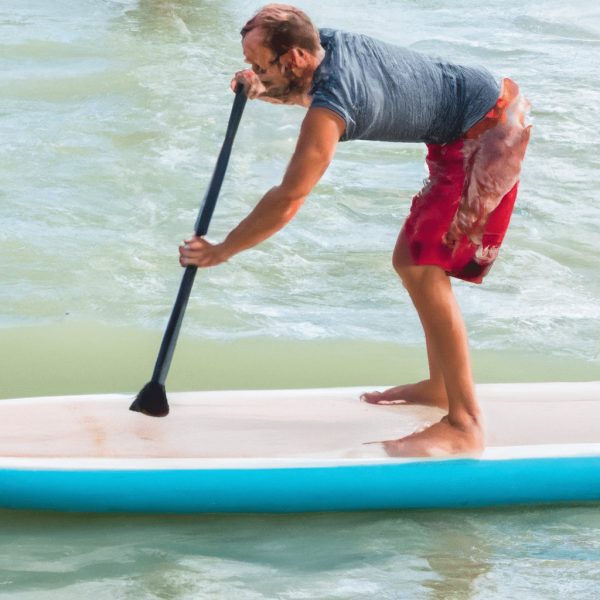You’re not alone if you’ve ever wondered why SUP (Stand Up Paddle) boards can leave a hefty dent in your wallet.
The allure of gliding across serene waters has made these boards increasingly popular, but their price tags have left many scratching their heads.
However, various factors contribute to the high cost of SUP boards, from the materials used to the intricate design and manufacturing processes involved.
In this article, we’ll explore the reasons behind the seemingly steep prices of these boards, allowing you to gain a deeper understanding of the value they provide.
Review contents
Materials Used
Epoxy Resin
Epoxy resin is a critical component in the manufacturing of high-quality SUP boards. It is known for its durability, strength, and resistance to water damage. Epoxy resin provides a solid and reliable base for the board, ensuring it can withstand the demands of paddling in various water conditions. Its higher cost compared to other resins reflects its superior quality and performance.
Fiberglass
Fiberglass is another important material used in the construction of SUP boards. It adds strength and rigidity to the board while remaining lightweight. Fiberglass helps to enhance the overall durability and resilience of the board, allowing it to withstand the pressures of paddling over time. Its use in manufacturing contributes to the higher cost of SUP boards.
Carbon Fiber
Carbon fiber is a high-performance material known for its exceptional strength-to-weight ratio. It is commonly used in premium SUP boards, making them lightweight, responsive, and incredibly strong. Using carbon fiber significantly increases the cost of SUP boards due to the expensive production process and the material’s inherent high cost.
Wood
Some SUP boards incorporate wood in their construction, particularly as a wooden veneer or stringer. Wood adds a natural and aesthetically pleasing element to the design of the board while also providing additional strength. The use of wood can elevate the price of SUP boards due to the added craftsmanship and materials involved.
Inflatable SUPs
Inflatable SUPs, also known as iSUPs, have gained popularity in recent years. These boards are made from PVC materials and are more affordable than traditional rigid boards. While inflatable SUPs may be cheaper, they still require quality materials and manufacturing processes to ensure durability and performance. The cost of manufacturing these boards contributes to their overall price.
Manufacturing Process
Handmade vs. Mass Production
The manufacturing process of SUP boards can vary depending on whether they are handmade or mass-produced. Handmade boards involve meticulous craftsmanship, attention to detail, and labor-intensive work, significantly contributing to their higher price. Mass production, on the other hand, allows for economies of scale, reducing production costs and ultimately lowering the price for consumers.
Shape Design and Shaping Process
The shape design and shaping process are crucial in creating a well-performing SUP board. Manufacturers invest time and resources in developing innovative shapes that provide stability, maneuverability, and speed. This design process often involves extensive research, prototyping, and testing, all of which add to the overall cost of the boards.
Quality Control
To ensure the highest standards of quality, SUP board manufacturers implement strict quality control measures. This includes inspections throughout the manufacturing process, testing the boards for strength and durability, and adhering to industry standards. The cost of implementing quality control procedures is reflected in the price of the boards.
Labor Costs
Labor costs play a significant role in the pricing of SUP boards. Handmade boards require skilled craftsmanship, and the labor-intensive nature of their production drives up the overall cost. Even in mass production, labor costs are still a consideration, as workers are involved in shaping, laminating, and finishing the boards. The expertise and time invested by skilled workers contribute to the higher price of SUP boards.
Brands and Reputation
Certain brands have established a reputation for producing high-quality SUP boards with superior performance and durability. These brands often invest in research and development to consistently innovate and improve their products. The trust and recognition associated with reputable brands can influence the pricing of SUP boards, as customers are willing to pay a premium for their reliability and reputation.
This image is the property of images.unsplash.com.
Supply and Demand
Limited Supply
The supply of SUP boards is not infinite, leading to higher prices due to limitations in production capacity. Manufacturers can only produce a certain number of boards within a given timeframe, which may not be able to meet the growing demand. The limited supply drives up prices, creating a market where demand often outweighs the available inventory.
Increased Demand
SUP boarding has grown in popularity in recent years as more people embrace outdoor water activities. The surge in demand for SUP boards has resulted in increased production and higher prices. Manufacturers must meet the rising demand while ensuring the quality and performance of their boards, which can contribute to the higher cost of the products.
Brand Value and Exclusivity
Certain brands in the SUP industry have carefully cultivated a sense of exclusivity and premium value. They create a perception of superior quality and exclusivity by positioning themselves as luxury or high-end brands. The allure of owning a coveted brand can drive up the price of SUP boards, allowing manufacturers to command higher prices based on their brand value.
Research and Development
Technological Advancements
Research and development are integral to the SUP industry, driving technological advancements and innovative features. Manufacturers invest in developing new materials, manufacturing techniques, and design improvements to create boards that offer enhanced performance, durability, and overall user experience. The costs associated with research and development are reflected in the price of SUP boards.
Performance-Enhancing Features
Manufacturers continuously strive to improve the performance of SUP boards through the incorporation of advanced features. These may include increased rigidity, improved stability, enhanced speed, and better maneuverability. The development and integration of such performance-enhancing features require investment in both research and production, contributing to the higher price of SUP boards.
Testing and Prototyping
Before a SUP board reaches the market, extensive testing and prototyping are undertaken to ensure optimal performance and durability. These processes involve repeated trials, adjustments, and improvements to fine-tune the boards.
The costs incurred during testing and prototyping are part of the overall expenses absorbed by manufacturers, which are then reflected in the final pricing of the SUP boards.
This image is the property of images.unsplash.com.
Import Costs and Taxes
Shipping Expenses
SUP boards are often manufactured in different countries, necessitating shipping to reach their intended markets. Shipping expenses, such as transportation fees, insurance, and handling costs, are borne by the manufacturers and importers. These additional costs are factored into the pricing of SUP boards, adding to their overall expense.
Customs and Import Duties
When SUP boards are imported into a country, customs duties and import taxes are imposed on the products. These fees are government-imposed charges and vary depending on the country of import. The customs duties and import taxes are added to the overall cost of the boards, thereby increasing their price.
Currency Exchange Rates
The exchange rate between currencies can significantly impact the cost of imported SUP boards. Fluctuations in exchange rates can lead to changes in pricing, as manufacturers or importers may need to account for variations in the currency exchange when setting prices. Currency exchange rates contribute to the final cost of SUP boards in international markets.
Marketing and Advertising
Promotion Expenses
Marketing and advertising play a vital role in promoting SUP boards and reaching potential customers. Manufacturers invest in various marketing strategies, such as digital and print advertising, social media campaigns, and collaborations with influencers and athletes. The expenses incurred in marketing and promoting SUP boards are factored into their pricing.
Sponsorships and Endorsements
Many SUP board manufacturers sponsor athletes, events, and competitions to increase brand visibility and credibility. These sponsorships require financial investment, including endorsement contracts, event sponsorships, and promotional merchandise. These costs are passed on to the consumer, contributing to the higher prices of SUP boards.
This image is the property of images.unsplash.com.
Distribution and Retail Markup
Wholesale to Retail Price Markup
As SUP boards move through the distribution chain, each level of the supply chain adds a markup to the product. Once the manufacturer sells the boards to wholesalers or distributors, they mark up the price to cover their costs and make a profit. Retailers further add their markup to cover their expenses and generate profit. These markups at each stage of distribution contribute to the final price paid by consumers.
Distribution Costs
The costs associated with distributing SUP boards include transportation, storage, and logistics expenses. Manufacturers and distributors must factor in these costs when determining the price of the boards. The more extensive and widespread the distribution network, the higher the associated expenses, which subsequently impact the price of SUP boards.
Physical Store Expenses
Retailers operating physical stores incur various expenses such as rent, utilities, staff salaries, and inventory management. These expenses are included in the overall cost of doing business, and retailers must incorporate them into the pricing of SUP boards. The brick-and-mortar presence of retailers contributes to the higher prices customers encounter when purchasing SUP boards.
Accessories and Additional Features
Paddles
Paddles are essential accessories for SUP boarding and come in various materials and designs. Higher-quality paddles are often made from lightweight and durable materials, making them more expensive. The choice of material, design, and overall quality of the paddle can affect its price and subsequently impact the total cost when purchasing a SUP board with an included paddle.
Leashes
Leashes are essential for SUP board safety, helping to keep the rider connected to their board in case of falling off. The cost of leashes depends on factors such as length, material, and quality of construction. High-quality leashes that provide enhanced durability and safety measures often command a higher price, adding to the overall cost of SUP board purchases.
Fins
Fins contribute to a SUP board’s stability, tracking, and overall maneuverability. Depending on the type and quality of fins, they can vary in price. Premium fins made from high-performance materials may come at a higher cost. The inclusion of quality fins adds to the overall price of SUP boards to ensure optimum performance for riders.
Deck Pads
Deck pads offer grip and comfort for riders, making them an essential accessory for SUP boards. The quality and design of deck pads can vary, with higher-end pads often being more expensive due to their enhanced quality and features. The additional cost of including a top-quality deck pad is ultimately reflected in the overall price of SUP boards.
Bungee Systems
Some SUP boards feature bungee systems allowing riders to secure and transport gear or belongings while on the water. The inclusion and quality of these bungee systems can affect the final price of SUP boards. Boards with well-designed and durable bungee systems may command a higher price, but they offer added convenience and versatility for riders.
Branding and Design
Trademark and Copyright Protection
SUP board manufacturers invest in trademark and copyright protection for their brand names, logos, and unique designs. This legal protection ensures that their intellectual property is safeguarded and cannot be replicated easily by competitors. The costs associated with obtaining and maintaining these rights are part of the overall expenses absorbed by manufacturers, contributing to the pricing of their SUP boards.
Aesthetic Appeal and Custom Designs
The aesthetic appeal of a SUP board and the option for custom designs can impact its price. Manufacturers often collaborate with designers or artists to create visually stunning boards with unique graphics or artwork. Custom designs require additional time, effort, and resources, all of which contribute to the higher cost of SUP boards.
Conclusion
The high cost of SUP boards can be attributed to various factors. The materials used, such as epoxy resin, fiberglass, carbon fiber, and wood, contribute to the overall expense. The manufacturing process, which includes handmade craftsmanship, design, and quality control, adds to the price.
Supply and demand dynamics, research and development expenses, import costs, marketing efforts, distribution, and retail markups, as well as the inclusion of accessories and custom designs, all play a role in determining the final price of SUP boards. While the cost may seem substantial, the investment in a high-quality SUP board ensures durability, performance, and an enjoyable paddling experience.





































